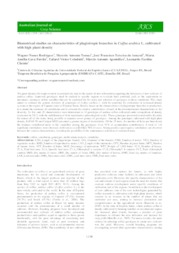Biometrical studies on characteristics of plagiotropic branches in Coffea arabica L. cultivated with high plant density.
Biometrical studies on characteristics of plagiotropic branches in Coffea arabica L. cultivated with high plant density.
Author(s): RODRIGUES, W. N.; TOMAZ, M. A.; AMARAL, J. F. T. do; FERRAO, M. A. G.; COLODETTI, T. V.; CHRISTO, L. F.
Summary: The great demand for improvements in productivity lead to the search of new information regarding the behaviour of new cultivars of arabica coffee. Improved genotypes need be studied in specific regions to evaluate their potential, such as the exploration on mountains, aiming to define variables that can be exploited for the study and selection of genotypes in those conditions. This study aimed to evaluate the genetic diversity of genotypes of Coffea arabica L. with the potential for cultivation in increased-density systems in the region of Caparaó (state of Espírito Santo, Brazil), based on the characteristics of plagiotropic branches in production, to evaluate the existence of correlations and to estimate the relative contributions of each of the aforementioned characteristics to the diversity. To this end, 25 characteristics were determined in 16 genotypes of arabica coffee cultivated under competition of density (evaluated in 2013, with the stabilisation of their reproductive phenological cycle). These genotypes presented considerable diversity for almost all of the traits, being possible to separate seven groups of genotypes. Among the genotypes cultivated with high plant density, IAPAR 59 and Catiguá MG2 presented a greater degree of dissimilarity. Of the 25 traits, the number of fruits per branch and the biomass contributed more to the variability among the genotypes (over 95% of accumulated contribution). A total of 111 significant correlations were observed, with values over |0.60| in 78% of cases. Strong positive and negative correlations are observed between the various characteristics, revealing the possibility of the simultaneous selection of correlated traits.
Publication year: 2014
Types of publication: Journal article
Unit: Embrapa Coffee
Keywords: Análise, Coffea Arábica, Densidade de Plantio, Genótipo
Observation
Some of Embrapa's publications are published as ePub files. To read them, use or download one of the following free software options to your computer or mobile device. Android: Google Play Books; IOS: iBooks; Windows and Linux: Calibre.
Access other publications
Access the Agricultural Research Database (BDPA) to consult Embrapa's full library collection and records.
Visit Embrapa Bookstore to purchase books and other publications sold by Embrapa.

